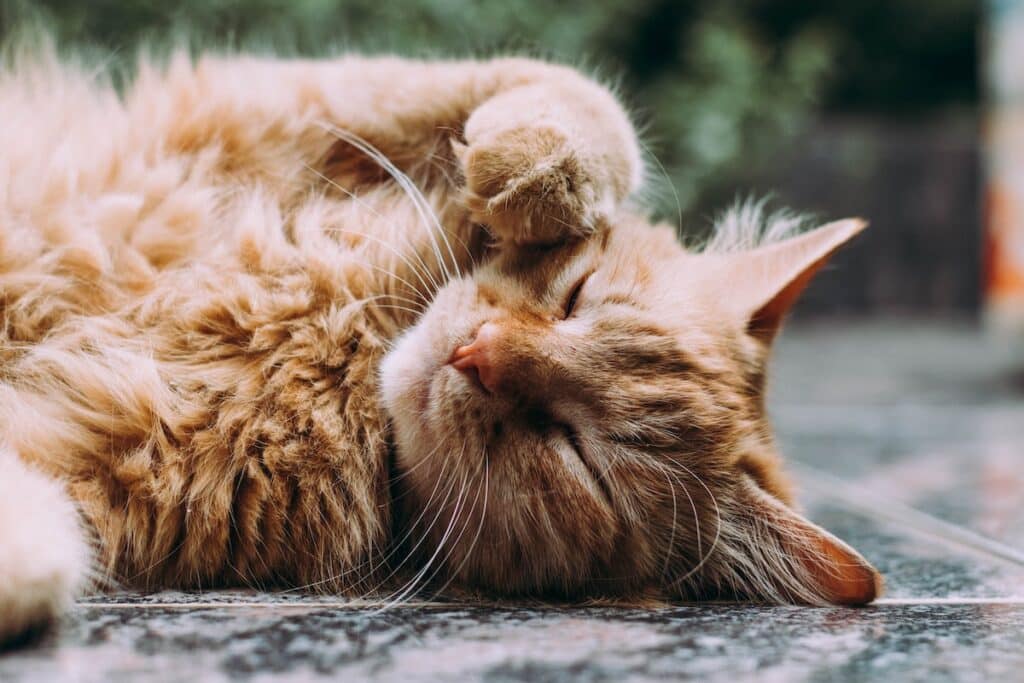The old “seven year” rule is simple but not quite accurate because cats age more rapidly during the first two years of life. In a cat’s very first year, he or she reaches the human age equivalent of 15. By a cat’s second year, he or she is the equivalent of age 24. This cat age chart (in human years) will help you determine your cat’s age equivilent.
If we think like a cat, here’s how a cat’s age compares to a human’s age. Of course, there are some differences in age conversion depending on breed, weight, and other factors, but this chart gives you a general idea.

How to Figure Out Your Cat’s Age
In some cases you need to apply other cues to determine its age besides using a cat age chart. The qualities listed below are basic principles. However, each cat will exhibit them differently based on their health, prior treatment, and environment. Consult a veterinarian for the best guidance.
- A cat’s teeth: The teeth of cats tend to become increasingly discolored as they age. White teeth indicate a cat that is likely under a year old. The age of the cat may be between one and two years old if there is some yellowing. Ages 3 to 5 may be approximated by tartar accumulation on all of the teeth, but keep in mind that some cats are more prone to tartar accumulation than others, particular foods may encourage tartar, and the absence of tartar may just be a sign of prior dental care. Although health problems and other factors (such as prior dental procedures) may also contribute to tooth loss, missing teeth may indicate that the cat is elderly.
- A cat’s coat: Typically, a cat’s fur gets thicker and coarser as it ages. (Remember that various breeds and hybrids may have varying coat densities and may naturally have fine or thick fur at any age.) Patches of gray or white may appear on senior cats.
- A cat’s muscle tone: Older cats tend to be bonier and have more skin than younger cats, and as they get older, their shoulder bones may protrude more.
- A cat’s eyes: Young cats have exceptionally clear, bright eyes that, depending on their health and breed, are typically discharge-free. The cat’s irises may look ragged as it ages. Although a cat with foggy eyes may be elderly, cloudiness can also be caused by medical disorders, some of which call for rapid attention. Consult a vet right away if your cat’s eyes are clouded or watery or if she is frequently squinting. If left untreated, several eye problems can quickly deteriorate and become more painful.
FAQs
Cat age charts are a great way to estimate how old your cat may be, but it’s important to remember that these charts are not always 100% accurate. Every cat is different and may age differently than other cats.
For example, some cats may age more quickly than others, while some cats may age more slowly. Additionally, the age of a cat can depend on the breed, size, and health of the cat. For example, larger cats may age more quickly than smaller cats, and cats with health issues may age faster than healthy cats.
It’s also important to note that the age charts are generalizations and may not take individual factors into account. So it’s important to remember that the age chart is just a guideline and is not always an exact estimation of your cat’s age.
If you’re ever unsure of your cat’s age, it’s best to consult your vet. Your vet can give you a more accurate estimation of your cat’s age based on their experience and expertise.
An age calculator can take into account factors such as a cat’s breed, size, and weight. This can give you a more accurate estimate of your cat’s age in human years. Plus, you can use the calculator to compare your cat’s age to other cats in its breed or size range. If you’re looking for a cat age calculator, there are plenty of good options out there. For example, the Omnicalculator has a cat age calculator that you can use for free. You just need to plug in your cat’s breed, size, and weight, and the calculator will give you an estimation of your cat’s age in human years.
The short answer is yes. There are a variety of cat age calculators available online that can help you determine your cat’s age in months. These calculators take into account your cat’s size, breed, and health to give you a more accurate estimate of your kitty’s age.
A 20 year old cat is 96 years in human years.
A 10 year old cat is 56 years in human years.
A 3 year old cat is 28 years in human years.
A 2 year old cat is 24 years in human years.
A 1 year old cat is 15 years in human years.
A 13 year old cat is 68 years in human years.
A general rule of thumb is that cats age much more quickly than dogs. In their first two years of life, cats age at a rate of roughly four human years to every one cat year. Between two and eight years, cats age at a rate of about two human years for every one cat year. After eight years of age, cats age at a rate of about one human year for every one cat year.
On the other hand, in their first two years of life, dogs age at a rate of about 10 to 15 human years for every one dog year. Between two and six years, dogs age at a rate of about four human years for every one dog year. After six years of age, dogs age at a rate of about five human years for every one dog year.














